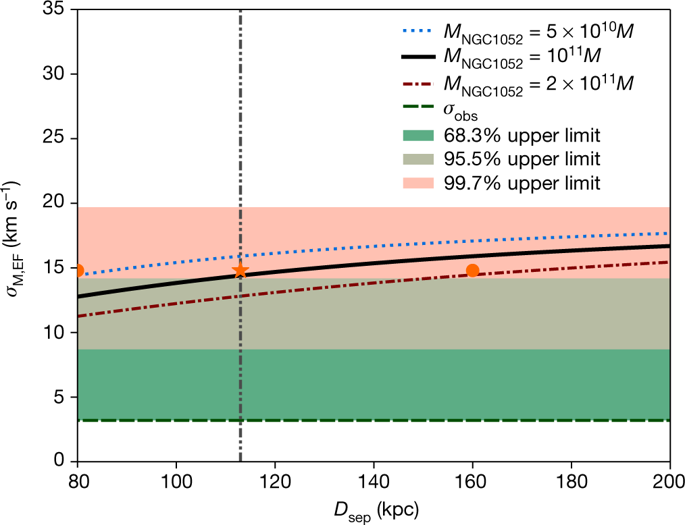Our official English website, www.x-mol.net, welcomes your
feedback! (Note: you will need to create a separate account there.)
Does the galaxy NGC1052–DF2 falsify Milgromian dynamics?
Nature ( IF 50.5 ) Pub Date : 2018-09-01 , DOI: 10.1038/s41586-018-0429-z Pavel Kroupa 1, 2 , Hosein Haghi 1, 3 , Behnam Javanmardi 4 , Akram Hasani Zonoozi 1, 3 , Oliver Müller 5 , Indranil Banik 6 , Xufen Wu 7, 8 , Hongsheng Zhao 6, 9 , Jörg Dabringhausen 2
Nature ( IF 50.5 ) Pub Date : 2018-09-01 , DOI: 10.1038/s41586-018-0429-z Pavel Kroupa 1, 2 , Hosein Haghi 1, 3 , Behnam Javanmardi 4 , Akram Hasani Zonoozi 1, 3 , Oliver Müller 5 , Indranil Banik 6 , Xufen Wu 7, 8 , Hongsheng Zhao 6, 9 , Jörg Dabringhausen 2
Affiliation

|
Galaxies normally have far more dark matter than normal matter, but the dynamics of objects within the ultra-diffuse galaxy NGC1052–DF2 suggest that it has a very little dark matter component. Most galaxies studied need a component of dark matter associated with them in order to explain their observed properties. Normally there is far more dark matter than normal matter, with an average of 30 times more for galaxies about the mass of the Milky Way. Dwarf galaxies are thought to have even higher ratios of dark to normal matter (more than 400 times as much). Pieter van Dokkum and colleagues report that the ultra-diffuse galaxy NGC1052–DF2 has a dynamical mass, determined by the motions of globular-cluster-like objects, that is essentially the same as the mass in stars, meaning that it does not have a dark matter component. Studies of galaxy surveys in the context of the cold dark matter paradigm have shown that the mass of the dark matter halo and the total stellar mass are coupled through a function that varies smoothly with mass. Their average ratio Mhalo/Mstars has a minimum of about 30 for galaxies with stellar masses near that of the Milky Way (approximately 5 × 1010 solar masses) and increases both towards lower masses and towards higher masses1,2. The scatter in this relation is not well known; it is generally thought to be less than a factor of two for massive galaxies but much larger for dwarf galaxies3,4. Here we report the radial velocities of ten luminous globular-cluster-like objects in the ultra-diffuse galaxy5 NGC1052–DF2, which has a stellar mass of approximately 2 × 108 solar masses. We infer that its velocity dispersion is less than 10.5 kilometres per second with 90 per cent confidence, and we determine from this that its total mass within a radius of 7.6 kiloparsecs is less than 3.4 × 108 solar masses. This implies that the ratio Mhalo/Mstars is of order unity (and consistent with zero), a factor of at least 400 lower than expected2. NGC1052–DF2 demonstrates that dark matter is not always coupled with baryonic matter on galactic scales.
中文翻译:

星系 NGC1052-DF2 是否伪造了米尔格罗米安动力学?
星系通常含有比正常物质多得多的暗物质,但超漫射星系 NGC1052-DF2 中物体的动力学表明它只有很少的暗物质成分。大多数研究的星系都需要与它们相关的暗物质成分,以解释它们观察到的特性。通常暗物质比正常物质多得多,对于银河系质量的星系,暗物质平均多 30 倍。矮星系被认为具有更高的暗物质与正常物质的比率(超过 400 倍)。Pieter van Dokkum 及其同事报告说,超扩散星系 NGC1052-DF2 的动力学质量由球状星团状物体的运动决定,基本上与恒星的质量相同,这意味着它没有暗物质成分。在冷暗物质范式背景下的星系调查研究表明,暗物质晕的质量和恒星总质量通过一个随质量平滑变化的函数耦合。对于恒星质量接近银河系(大约 5 × 1010 太阳质量)的星系,它们的平均 Mhalo/Mstars 比率最小值约为 30,并且朝着较低质量和较高质量的方向增加1,2。这种关系的分散性尚不清楚。通常认为,对于大质量星系,它小于两倍,但对于矮星系 3,4 则要大得多。在这里,我们报告了超扩散星系 5 NGC1052-DF2 中十个发光的球状星团状物体的径向速度,该星系的恒星质量约为 2 × 108 太阳质量。我们推断它的速度色散小于 10。每秒 5 公里,置信度为 90%,我们由此确定它在 7.6 秒差距半径内的总质量小于 3.4 × 108 太阳质量。这意味着 Mhalo/Mstars 的比率是统一的(并且与零一致),至少比预期低 400 倍2。NGC1052-DF2 表明暗物质并不总是与星系尺度上的重子物质耦合。
更新日期:2018-09-01
中文翻译:

星系 NGC1052-DF2 是否伪造了米尔格罗米安动力学?
星系通常含有比正常物质多得多的暗物质,但超漫射星系 NGC1052-DF2 中物体的动力学表明它只有很少的暗物质成分。大多数研究的星系都需要与它们相关的暗物质成分,以解释它们观察到的特性。通常暗物质比正常物质多得多,对于银河系质量的星系,暗物质平均多 30 倍。矮星系被认为具有更高的暗物质与正常物质的比率(超过 400 倍)。Pieter van Dokkum 及其同事报告说,超扩散星系 NGC1052-DF2 的动力学质量由球状星团状物体的运动决定,基本上与恒星的质量相同,这意味着它没有暗物质成分。在冷暗物质范式背景下的星系调查研究表明,暗物质晕的质量和恒星总质量通过一个随质量平滑变化的函数耦合。对于恒星质量接近银河系(大约 5 × 1010 太阳质量)的星系,它们的平均 Mhalo/Mstars 比率最小值约为 30,并且朝着较低质量和较高质量的方向增加1,2。这种关系的分散性尚不清楚。通常认为,对于大质量星系,它小于两倍,但对于矮星系 3,4 则要大得多。在这里,我们报告了超扩散星系 5 NGC1052-DF2 中十个发光的球状星团状物体的径向速度,该星系的恒星质量约为 2 × 108 太阳质量。我们推断它的速度色散小于 10。每秒 5 公里,置信度为 90%,我们由此确定它在 7.6 秒差距半径内的总质量小于 3.4 × 108 太阳质量。这意味着 Mhalo/Mstars 的比率是统一的(并且与零一致),至少比预期低 400 倍2。NGC1052-DF2 表明暗物质并不总是与星系尺度上的重子物质耦合。











































 京公网安备 11010802027423号
京公网安备 11010802027423号